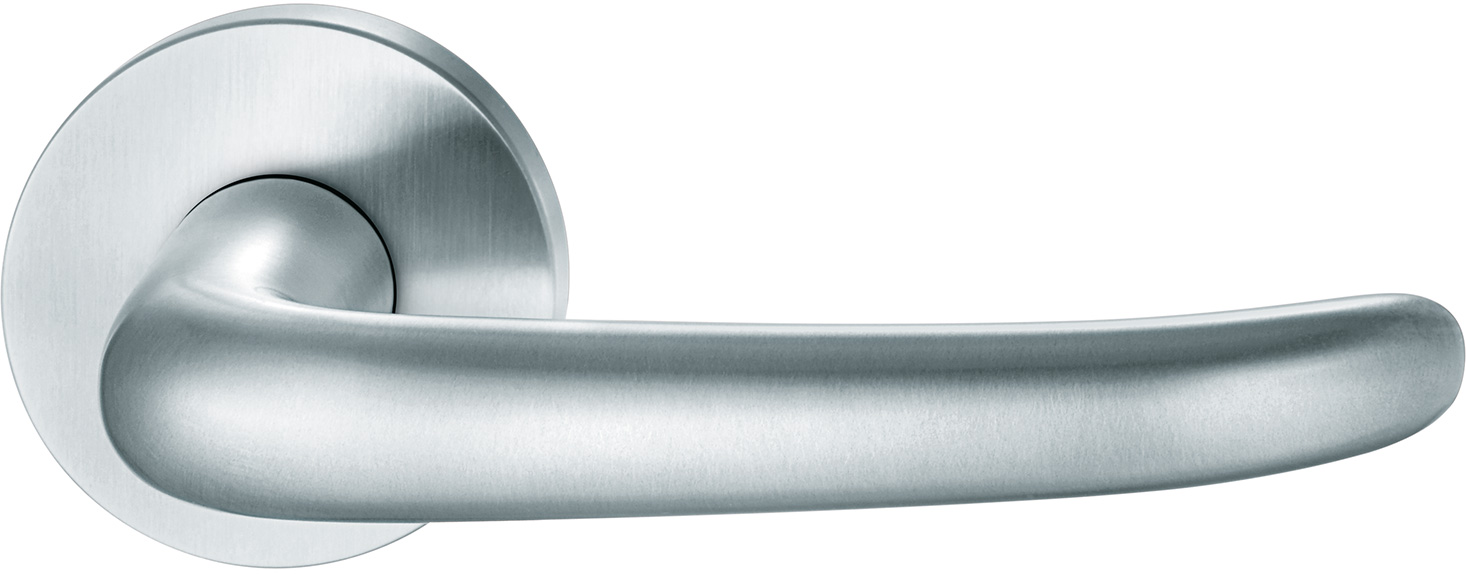Stainless Steel
The bright solution for frequently used doors
Stainless steel is an excellent choice for door and window hardware because its surface is extremely corrosion-resistant, hardly shows knock and scratch marks however roughly treated, is extremely hard-wearing, and is very easy to look after.
Stainless Steel
In 1912, Krupp in Essen, received the first patents for a new material which became familiar in pre-war Germany under the names “Nirosta” (never rust) and “V2a-steel”.
A variety of applications quickly opened up for this new material: from the construction of containers in the chemical industry through to designs in car and aircraft construction, from building materials to household equipment. The general term of stainless steel includes more than 100 different steels which resist corrosion and acids. When making our fittings we use a chrome-nickel steel which, according to DIN 17 440 takes the material number 1.4301. It contains approx. 18 % chrome and 8 % nickel. This alloy has proven itself in the building trade.
Characteristics of stainless steel
Stainless steel is outstanding in its suitability for door and window fittings as its surface is extremely resistant to corrosion, even when very roughly treated its scarcely shows traces of dents or scratches, its shows little wear even in continuous use and, above all due to the additional alloys of chrome and nickel, it requires very little care. An invisible passive layer forms on its surface which is even supposed to have bactericidal properties.
Places it is used
We recommend stainless steel door and window hardware for all heavily used doors, especially in public buildings, hospitals, on ships and service areas, in parks and sports facilities. Just about any high traffic area where hardware should be durable and easy to care for.
Care
In principle, architectural fittings made of stainless steel need no care. Traces of dirt can be removed with a moist cloth. If, after some time, exterior fittings or fittings in chlorinated swimming pools show traces of surface rust, this will not be from the material itself but will have been transported from outside to the fitting. This can be removed with vigorous rubbing.
Notes on selection
When selecting and ordering door and window fittings and their accessories, to avoid queries, misunderstandings and the associated waste of time, all of the genera explanations and technical information in this catalogue should be considered.
Finishes
Stock versions made of matt stainless steel are particularly robust. Mirror finish stainless steel is an environmentally friendly alternative to chrome-plated surfaces and is made to order.
Finishes
Stainless steel and ErgoSystem®
Stainless steel is a material which is outstandingly well suited for use in bathrooms and sanitary areas, as its surface is extremely resistant to corrosion, even when very roughly treated its scarcely shows traces of dents or scratches, its shows little wear even in continuous use and, above all due to the additional alloys of chrome and nickel, it requires very little care. An invisible passive layer forms on its surface which is even supposed to have bactericidal properties.
FSB offers the ErgoSystem® with finishes of stainless steel fine matt (FSB 6204) and stainless steel mirror finish (FSB 6205). Stock versions made of stainless steel fine matt are particularly robust. The version with a stainless steel mirror finish is an environmentally friendly alternative to chrome-plated surfaces and is made to order.
We recommend the ErgoSystem® made of stainless steel for heavily used areas, especially in public buildings, hospitals, old people’s and care homes, public authorities, on ships, in motorway service areas, parks and sporting facilities, just about anywhere where there are lots of people and a fitting is to continue to work long term while being easy-care.
Easy care
In principle, architectural fittings made of stainless steel need no care. Traces of dirt can be removed with a moist cloth. If, after some time, exterior fittings or fittings in chlorinated swimming pools show traces of surface rust, this will not be from the material itself but will have been transported from outside to the fitting. This can be removed with vigorous rubbing. When cleaning powder-coated aluminium parts in the ErgoSystem (supports, fixings etc.) no abrasive cleaning agents may be used. They inevitably lead to fine scratches and thus to a matt, dull surface.






